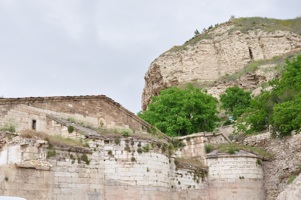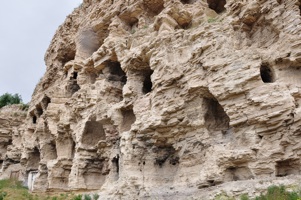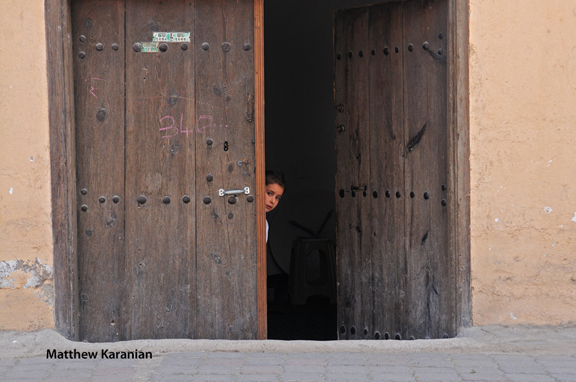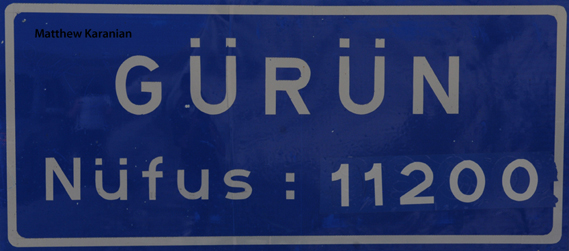
 | |
| Research > Armenian Studies > Gurin | Contact |
 Photo: George Aghjayan, 2013 | The town became part of the Kingdom of Cappadocia (province of Kataonia) and, for a brief period, part of an expanded Kingdom of Sophene (Tsop'k').[3] When the Byzantine Empire took over those lands, Gaurēnē was attached to Lesser Armenia. It remained part of Byzantine Armenia until the Ottoman Empire was established. When its Armenian residents were either massacred or exiled in 1915, the town was part of the vilayet of Sebastia/Sivas. Its Armenian Apostolic community was under the jurisdiction of the Cilician Holy See. The town also had Armenian Catholic and Armenian Protestant churches. Historically, there may also have been a small group of Armenians in Gurin belonging to the Greek Orthodox Church (Hay Horom). |
| By the second half of the 19th century, Gurintsis had established trade networks with cities that included Alexandria (Egypt), Gesaria/Kayseri, Varna (Bulgaria) and Trabzon. As was the case in many Ottoman Armenian communities, some Gurintsis (mainly men) started immigrating to the United States for economic and security reasons, especially following the 1895 Hamidian Massacres. A Gurintsi student association was set up in Boston in 1899. The Armenian genocide put the bulk of the surviving population into exile and most refugees ended up in Lebanon, Syria and Egypt. From there, a few chose to immigrate to Soviet Armenia, but many immigrated to Argentina, France, Greece and the United States in the decades that followed the genocide. The student association founded in Boston evolved into the Compatriotic Union of Gurin to assist genocide survivors and their families. Chapters of the Union were set up in Aleppo, Athens, Beirut, Boston, Buenos Aires, Lyon and New York. They held meetings and gatherings, published two periodicals (1930-1933 NY and 1976-1981 NJ) and a memorial book (1974, Beirut). The Union join forces with Gurintsis established in Erevan to found the town of Nor Kyurin (New Gurin in Eastern Armenian), situated 15km south of capital Erevan, near Nor Kharberd (New Kharpert). The Compatriotic Union was dissolved in the late 20th century, as the last Armenians born in Gurin aged and passed away. |
 Photo: George Aghjayan, 2013 |
 Photo: Matthew Karanian, 2014 |
On this page, you will find the following two sections:
|


Houshamadyans (memorial publications)
Documents of the Compatriotic Union of Gurin
(Armenian and some English).
Gurini Housh (Memory of Gurin), quadrimestral, 1930-1933, Suren Surenian.
(Armenian).
Badmakirk' Gurini (History Book of Gurin), Bedros Minasian, ed., Beirut: Sevan, 1974.
(Armenian and partial English translation).
Gurini Housher (Gurin's Remembrances), Levon Hekimian, ed., Elberon NJ, circa 1976-1981.
(Armenian and some English).
Gurin, in: Agheksantrian, Antreas V. 1911. Badmout'ioun aganawor k'aghak'in Sepasdioy ew sahmanats' nora gam Ark'ebisgobosout'ean norin (History of Celebrated City of Sebastia/Sivas and its Surroundings or Archiepiscopacy). Venice: St Lazarus, pp. 372-379.
(Armenian, digitized by George Aghjayan).
Gurin, in: Badrig, Arakel. 1983. Badmakirk' youshamadean Sepasdioy ew kawari hayout'ean (History of the Armenians of Sebastia/Sivas and neighboring villages. Vol. 2: New Jersey, 1983, pp. 394-413.
(Armenian, digitized by George Aghjayan).
General References
Gürün, in: Yücel, Yrd. Doç. Dr. Ebubekir S. 2006. Salname-i Vilayet-i Sivas, vol. 1-3 (1870, 1871, 1872, 1875, 1876, 1880, 1882, 1883, 1884, 1886, 1888, 1890, 1903).
(Turkish, digitized by Luc Vartan Baronian from the collection of George Aghjayan).
Caza de Gurun, in: Cuinet, Vital. 2001 (re-edited from the 1891-1894 edition). La Turquie d'Asie. Géographie administrative , statistique descriptive et raisonnée de chaque province de l'Asie-mineure. Vol. VI. Les Éditions Istanbul.
(French, digitized by Luc Vartan Baronian from the collection of George Aghjayan).
Entry on Gurin, in: Ep'rigean, S. 1903. Badkerazart pnashkharhig parraran (Illustrated Native Dictionary). Volume II, Venice: Sourp Ghazar, pp. 436-439.
(Armenian, digitized by Luc Vartan Baronian, from the Mardigian Library collection at NAASR  ).
).
Dialecte d'Arabkir (includes Gurin), in: Adjarian, H. 1909. Classification des dialectes arméniens. Bibliothèque de l'école des Hautes études, publiée sous les auspices du Ministère de l'instruction publique. Paris: Librairie Honoré Champion, pp. 65-66.
(French, original copy from the University of Toronto Library, digitized by the Internet Archive in 2010 with funding from the University of Ottawa).
Gurin, in: Lapçinciyan, Teotoros (Teotik). 1921. Kolkot'a hay hokeworaganowtean (The Golgotha of the Armenian Clergy), Constantinople: H. Mateossian, pp. 126-129.
(Armenian, digitized by George Aghjayan).
Gurin: Chapter in S. M. Dzots'igean, 1947, Arewmdahay Ashkharh (Western Armenian Lands), New York, pp. 347-356.
(Armenian, digitized by Christine Sedef Arakelian).
Original Documents
The Gurin Census of 1828
(Armenian with an English translation).
Photos of Sourp Asdvadzadzin, by George Aghjayan, 2013.
Modern photos of Gurin, by Matthew Karanian, 2014.
Personal accounts, biographies
Arshaguni, A. A. 1927. Vahan Vartabedean ew Lipanani azkayin kavarragan zhoghovë (Vahan Vartabedian and the Regional Assembly of the Nation in Lebanon). Beirut: Hraztan, 75 pp.
Arshakuni, A. 2010. Vahan Vartabedian and the Armenian Provincial Assembly of Lebanon. Translated and annotated by Aris G. Sevag, 45 pp.
Chghlyan, Hakob. 1993. Erdvyal mardë : vaveragrakan aknarkner (The Sworn Man: Documentary Looks). Erevan: Hayastan Bats' Hamalsaran, 144 pp.
Dinkjian, Arax. 1980. Interview with Mrs. Arshalooys Hadidian in Hackensack NJ. Armenian Assembly Oral History Project.
Kredian, Armin. 2004. A Gurun shawl on a Cairo wall. In: Hovannisian, Richard G., Armenian Sebastia / Sivas and Lesser Armenia. Mazda Publishers, pp. 305-322.
Chapter 1 of: Tombalean, Hagop. 1964. Prunts'k' ew Oki: Hay Grrp'amardigi më Yousherë (Fists and Soul: Memories of an Armenian Boxer). Prefaced by Antranig Dzarugian. Beirut: Sevan, 152 pp.
(Armenian, digitized by Luc Vartan Baronian, from the Mardigian Library collection at NAASR  ).
).

ARMENIANS FROM GURUN (GURIN) 
A list of Gurintsi immigrants and genocide survivors compiled from various documented sources by Denis Der Sarkissian.
The following family pages will be interconnected. All contributions to these pages or to future Gurintsi pages are most welcome.
Afarian
Antikadjian
Arabian
Arboyan
Baronian
Begian
Bozigian
Dedeian
Der Sarkisian
Djemdjemian
Djghlian
Dzarougian
Gergerian
Gosdigian
Gureghian
Halajian
Kaynakian
Khredian
Klbashian
Kochounian
Melekian
Murmurian
Piranian
Siranosian
Terjanian
Tombalian
Vartabedian
Vranian
Zeytounjian
Zvartian